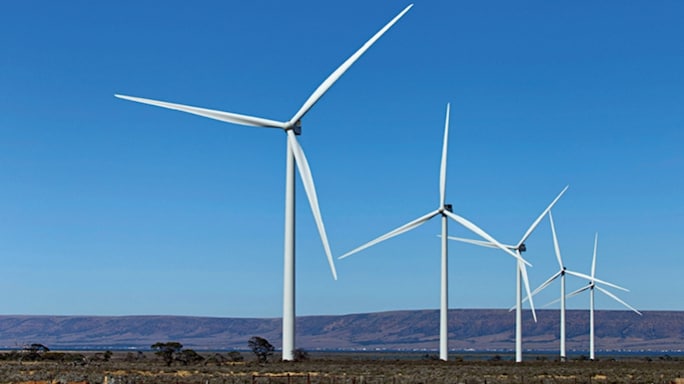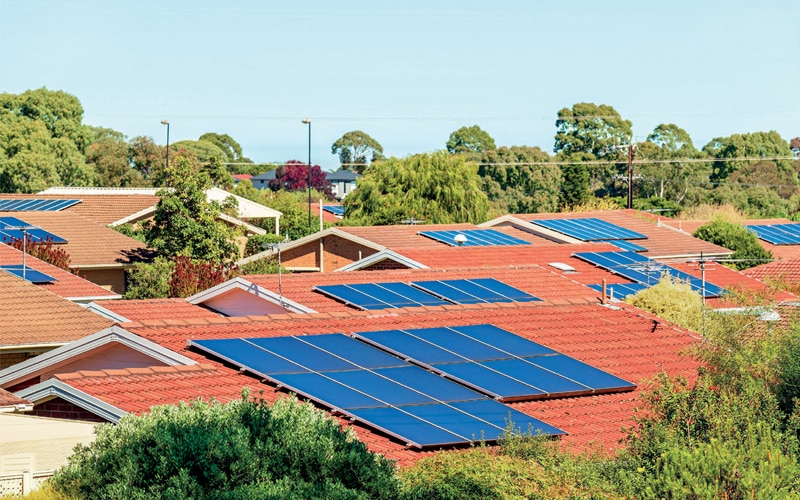- HOME
- /
- Features
- /
- Cover Story
- /
The Climate Changers: The Grid Goes Green
South Australia is building what it hopes will be the world’s first electrical grid that relies completely on renewable energy
 Alamy Stock Photo: Lincoln Fowler(turbines),
Alamy Stock Photo: Lincoln Fowler(turbines),
A decade ago, the main landmark in Port Augusta, South Australia, was a 200-meter-tall chimney puffing fumes from a coal-fired power station. “You could see it from 40-odd kilometers out,” says Gary Rowbottom, who worked at the plant for 17 years.
Today, the chimney is gone. The town’s chief landmark now is a tall tower topped by a dazzling light, where sunlight reflected from 23,000 mirrors on the ground is focused to power four giant greenhouses. Next door is a renewable energy park, home to 50 wind turbines and 2,50,000 solar panels.
Port Augusta is representative of a remarkable shift that has swept South Australia. In 2007, just one per cent of the state’s electricity came from solar and wind. Now it is more than 70 per cent—one of the highest proportons of any major grid in the world—and the state is ramping up to use only renewable power year-round.
This clean energy rush is highly instructive to the wider world, which needs to rapidly wean itself off fossil fuels to avert a climate disaster. To find out how such progress is possible, I met those leading the charge. The state’s renewable energy push began in 2002. At the time, South Australia’s electricity was very expensive, partly because its large spread-out grid is paid for by a relatively small population of just 1.8 million, and partly because the previous government had privatized the state’s electricity assets “on terms that wouldn’t benefit consumers,” says Tom Koutsantonis, the state’s current energy minister.
The next year, the state’s first wind farm, on the Fleurieu peninsula, was commissioned. This opened the floodgates to more renewable energy projects, with 24 onshore wind farms and five large-scale solar farms now operating. In 2008, the state government began incentivizing households to put solar panels on their roofs by offering generous payments for any excess solar energy that was fed back into the grid.
Now, more than 40 per cent of South Australian homes have solar panels—one of the highest rates of uptake in the world. In September 2023, a major new milestone was reached when the state’s entire electricity demand was met by rooftop panels alone.
In the Adelaide suburb of Netley, I meet engineer Adam Langham, who has 58 solar panels on his house and carport. They produce 12 times more power than he, his wife and two children consume. The government discontinued its subsidy in 2011, but smaller payments are still offered by private electricity companies, meaning the family makes more than enough money to pay off the cost of the installation.
“I’ve had quite a few friends call me up over the years and say, ‘OK, mate, solar panels, what’s the go?’ and I tell them, ‘They’re a no-brainer—go for it,’ ” says Langham.
I also, however, meet people for whom the switch to renewables has been challenging. Rowbottom and around 400 colleagues, for example, lost their jobs in May 2016 when Port Augusta’s coal station, the last one in the state, closed. Few were able to find jobs in the town’s new renewable energy sector. Rowbottom moved out of state, to Queensland, to work at another coal power plant, but has since found employment back in Port Augusta.
There have been other hurdles. In September 2016, almost the entire state experienced a blackout, lasting for days in some areas. It was triggered by a violent storm that knocked out more than 20 electricity pylons and cut three of the state’s four major transmission lines. Coal enthusiasts seized on the event to argue that renewables were unreliable.
Koutsantonis believes the state’s supply would have gone down regardless of its energy mix, because of the severe damage to transmission lines. But the South Australian government was determined to prove the naysayers wrong, he says. “We hated the ridicule we got from the rest of the country.”
 South Australia is among the world’s leaders in adopting rooftop solar panels. Photo credit: Andrey Moisseyev/Alamy Stock Photo
South Australia is among the world’s leaders in adopting rooftop solar panels. Photo credit: Andrey Moisseyev/Alamy Stock Photo
In 2017, it created a AU$150 million technology fund to provide grants or loans to businesses that could offer new technologies that would make the grid more resilient. The same year, the state took delivery of a giant battery, the first of its kind in the world. It was built by Tesla following a bet on Twitter between Mike Cannon-Brookes, Australia’s best-known tech billionaire, and Tesla boss Elon Musk. Musk told Cannon-Brookes that Tesla would get the battery installed and working in fewer than 100 days, otherwise it would be free. Luckily for Tesla, it achieved this in 63 days.
The battery, located near Jamestown, looks like hundreds of refrigerators lined up in rows in a field. Each is filled with lithium-ion cells that are all connected to form one big battery with a capacity of 194 megawatt-hours. The facility stores excess electricity, then sends it to the grid as needed.
It has since proved its worth on multiple occasions, including in August 2018, when lightning strikes caused widespread grid problems across the eastern half of Australia. Blackouts occurred across New South Wales and Victoria, but the lights stayed on in South Australia. Victoria and New South Wales have since built their own big batteries.
Another innovative project was a ‘virtual power plant’, also built by Tesla with some initial government funding. It comprises a network of solar panels and batteries that Tesla installed for free on thousands of government-owned social housing properties across South Australia. Software coordinates the individual systems so they function as a single power plant; surplus solar energy is traded on the electricity market.
Craig Renton, who lives in social housing in the outer Adelaide suburb of Elizabeth, joined the virtual power plant in August 2023. “My wife and I are pensioners and it saves us money—about AU$60 a quarter—which makes a difference,” he says. Renton says he couldn’t have afforded solar panels or a battery without the scheme. In this way, the virtual power plant is helping address the criticism that typically only the wealthy can afford green technologies.
“One of the principles that we have in this energy transition is that we want to make sure we don’t leave anyone behind,” says Scott Oster at the South Australian government’s energy department, who helped manage the project.
Despite all this progress, average electricity prices are still higher in South Australia than in most other parts of the country because the state still relies on gas-generated electricity when there isn’t enough sun and wind, and gas has become increasingly expensive in recent years. As a result, the most pressing issue is to find ways to store excess solar and wind energy so it can be used when there is a deficit, Koutsantonis says. One solution may be to use excess solar and wind energy to make hydrogen from water, which could be converted back into electricity by burning it or feeding it through hydrogen fuel cells.
To test this idea, the state government has committed AU$593 million to building a hydrogen power plant near the city of Whyalla, which is due for completion next year. If it works, the state will meet its target of running solely on renewables by 2030 and will probably have the world’s first large fossil fuel–free grid based on solar and wind energy.
(2023 New Scientist Ltd. All rights reserved. Distributed by Tribune Content Agency)
India’s Solar Revolution
India’s rooftop solar (RTS) revolution is gaining momentum, thanks to the government’s PM-Surya Ghar: Muft Bijli Yojana, which aims to install RTS in 10 million households within three years, through a subsidy outlay of Rs 75,021 crore. This initiative addresses previous barriers like high costs, limited awareness, and bureaucratic hurdles. RTS allows households to generate their own electricity, reducing energy bills and selling excess power back to the grid. As of November 2024, India’s current RTS capacity is 15.16 GW, with major contributions from states like Gujarat and Maharashtra. However, reaching the renewable energy target of 500 GW by 2030 will require quadrupling RTS adoption, say experts. The initiative boosts domestic solar manufacturing and creates opportunities for skilled jobs, promising economic and environmental benefits for years to come. With simplified processes, increased subsidies, and potential cost recovery within six years, RTS seems poised to transform India’s energy landscape.






